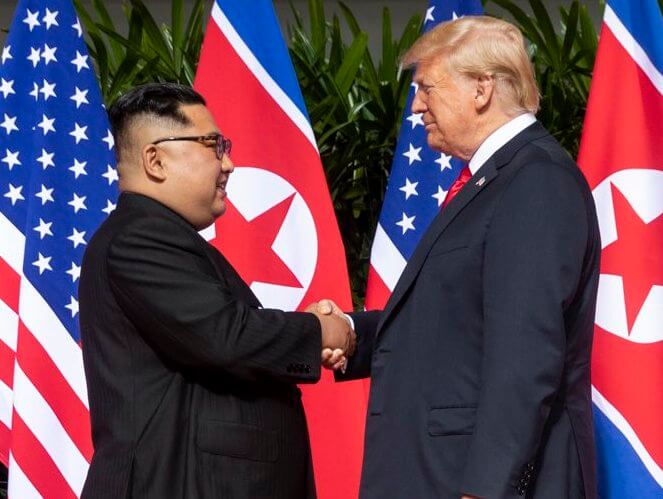Trump came into office in the midst of a heated diplomatic crisis with North Korea. The events surrounding the imprisonment and consequent
death of the American student Otto Warmbier initiated a heated war of words with escalating tensions during Trump’s first year in office. North Korea conducted a series of missile and nuclear tests, which for the first time demonstrated their ability to launch ballistic missiles with international-continental reach. Trump countered by threatening that if North Korea were to make any threats they would
“be met with fire and fury like the world has never seen”. Shortly after, North Korea respectively threatened that they were considering a strike on the US Air Force base on Guam.
The strong and fiery language used by Trump was ground-breaking. Never before has a US president resorted to such strong rhetoric on North Korea. In September 2017, Trump continued his new diplomatic approach by infamously referring to Kim Jing Un as a
“rocket man...on a suicide mission for himself and his regime”.
Although tensions were severe,
few experts actually thought that words would turn into action. A North Korean strike would have been suicidal, likely leading to the end of the regime. And although Trump is an unpredictable president, a preemptive strike from the US, which would result in full-on war, was likewise very unlikely. Trump preaches “America first” and a costly war, both in terms of human lives and money, was definitely not in line with his agenda.
Therefore, it was not a big surprise when tensions drastically eased in the beginning of 2018. Trump was, however, not the catalyst of this turnaround. It was instead
propelled by North and South Korea’s cooperation during the Pyeongchang Olympics and the two inter-Korean summits that followed. Later the same year, Trump and Kim met at a historical and unprecedented summit in Singapore. The summit was held in a very theatrical but surprisingly jolly fashion and resulted in a
joint declaration of full denuclearization of the Korean peninsula. Despite the fact that details of implementation were left out, diplomatic relations now seemed more promising than ever.
After the summit, Trump’s previously strong language flipped just as drastically. While speaking at a rally, he talked about his changed relationship with Kim and announced that he and the leader of North Korea
“fell in love”.
Things once again took a turn with the second summit in Hanoi in 2019.
Hopes were high. North Korea went in with ambitions of eased sanctions and the US went in with demands of total denuclearization according to the
“Libya model”. This time, Trump and Kim did not come to any agreement. Instead,
Trump walked out after rejecting North Korea’s offer to dismantle only some of its nuclear facilities in exchange for a total relief of sanctions. For Trump, his reputation back home was of high priority and he needed to deliver a win to his supporters. North Korea, on the other hand, was focused on getting sanctions eased, meanwhile not surrendering to the demands of total denuclearization. They feared the Libya model would take them down the same path as Muammar Gaddafi,
who renounced Libya's weapon of mass destruction program and was later forcibly removed. Consequently, the Hanoi summit did not result in any substantial outcome.
North Korea now
resumed its missile launching program, which had previously been halted during all of 2018. Trump was still wowed by his and Kim’s relationship. Since their last meeting, they have reportedly exchanged various
warm notes and letters. Though there is a seemingly affectionate relationship between the leaders, no tangible progress has been made. North Korea has continued to pursue its goal of stabilizing the military imbalance, however, now without interfering threats from Trump. It is also possible that Trump’s warm view of Kim is a contributing factor to why the UN Security Council has not been pushed by the US to enforce any new sanctions since 2017.
In the times of Covid-19, policy concerning North Korea has not been a hot topic of the US presidential election. In the last presidential debate, Trump boasted about how successful his administration has been in handling North Korea. The fact that North Korea as late as October 10th showed off their new intercontinental ballistic missiles in a military parade, was not mentioned. Trump further claimed that the mere absence of war is keeping the US safe. On the opposing side, Biden criticized Trump for legitimizing North Korea,
comparing Kim to Hitler and calling him a “thug”.
Looking into the future, is progress under the coming Biden administration possible? Biden did not mention North Korea considerably when campaigning and has only briefly stated an objective of a denuclearized North Korea in his
foreign policy plan. However, during the last debate, Biden stated that a summit would only happen if Kim would agree to
“draw down his nuclear capacity”. The actor that will definitely determine the future of the relationship is North Korea. In the beginning of every new US administration, North Korea has been known to
“test the metal” through provocative action. How Biden will respond to such action remains uncertain. Will Biden pick up the pieces left from Trump and continue the strong and fiery language, or will he revert to the policy of Obama? In four years, we might once again be back at square one.

